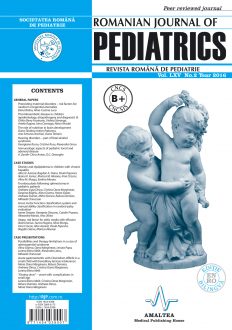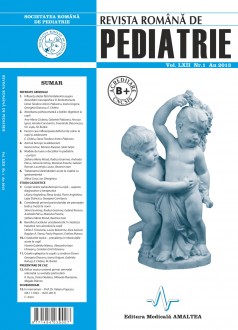SELECT ISSUE

Indexed

| |

|
|
|
| |
|
|
|

|
|
|
|
|
|
|
HIGHLIGHTS
National Awards “Science and Research”
NEW! RJP has announced the annually National Award for "Science and Research" for the best scientific articles published throughout the year in the official journal.
Read the Recommendations for the Conduct, Reporting, Editing, and Publication of Scholarly work in Medical Journals.
The published medical research literature is a global public good. Medical journal editors have a social responsibility to promote global health by publishing, whenever possible, research that furthers health worldwide.
ATOPIA, FACTOR DE RISC IN APARITIA OTITEI SEROASE LA COPIL
Alice Azoicăi, Alina Murgu, Aurica Rugina, Bogdan Stana, Ileana Ioniuc, Irina Criscov, Monica Alexoae and Paula Popovici
ABSTRACT
Otita medie seroasă cronică, cauză majoră a hipoacuziei în perioada copilăriei, este frecvent asociată cu sensibilizarea alergică. Prevalenţa în continuă creştere a atopiei la această vârstă implică o abordare multidisciplinară a copiilor cu adenoidite, otite recurente şi disfuncţii tubare, în vederea unui management patogenic complex.
Obiectivul studiului a constat în determinarea asocierii otitelor medii cu bolile alergice, şi implicaţiile acestei asocieri în tratamentul şi evoluţia pacienţilor.
Material şi metodă. S-a realizat un studiu retrospectiv care a inclus 92 de copii, cu vârste cuprinse între 6 luni şi 6 ani internaţi în Clinica II Pediatrie, Spitalul Clinic de Copii „Sf. Maria“, Iaşi, cu diagnosticul de otită medie, pe o perioadă de 1 an (ianuarie 2015 – ianuarie 2016).
Rezultate. Majoritatea cazurilor au fost otite supurate (61 de pacienţi), 31 de cazuri au fost otite seroase, dintre care 23 au fost recurente. Asocierea cu bolile alergice a fost mai frecventă la copiii cu otită seroasă (26/31 cazuri). 4 pacienţi cu otită supurată au prezentat reacţii adverse la antibiotice, cu implicaţii majore în evoluţia cazurilor. Asocierea cu refluxul gastroesofagian a fost relativ asemănătoare între cele 2 loturi (11/61 de cazuri şi respectiv 10/31 de cazuri), la 10 pacienţi atopici, obiectivându-se alergia la proteinele laptelui de vacă.
În concluzie, copiii cu otite medii, în special cei cu otite medii seroase recurente ar trebui investigaţi pentru determinarea coexistenţei atopiei şi a refluxului gastroesofagian, eventual cu dozarea markerilor de inflamaţie alergică sau a pepsinei în exsudatul otic, în vederea unui management terapeutic ţintit.
Keywords: otită seroasă, alergie, copii

